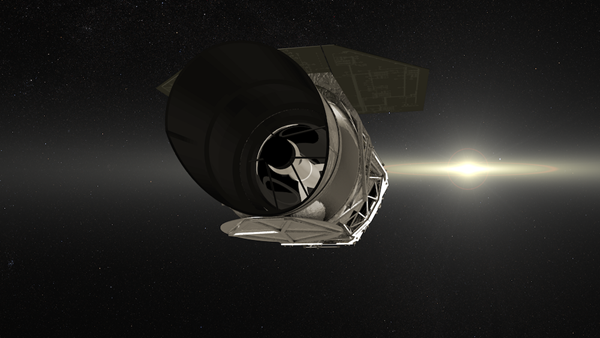The Wide Field Infrared Survey Telescope, abbreviated WFIRST, is poised to become one of astronomy’s top next-generation space telescopes — if it can get off the ground. This 2.4-meter (8 feet) telescope has been designed explore the universe at infrared (long) wavelengths, searching out millions of distant galaxies in the early universe just 500 million years or less after the Big Bang. But the telescope has had a troubled recent past: Despite a May 23 announcement that NASA has awarded a contract for the telescope’s primary instrument (the Wide Field Instrument [WFI]) to Ball Aerospace and Technologies Corporation, The Globe and Mail reported May 29 that the Canadian Space Agency will pull out of the NASA-led project due to a lack of funding.
With so many space telescopes already in astronomers’ arsenal — including the upcoming James Webb Space Telescope (JWST) — you may wonder why WFIRST is a big deal at all.
WFIRST will go after some of the biggest questions in cosmology today: dark matter and dark energy. While JWST will also seek out answers about these topics, and in much greater resolution, the trade-off is its field of view — Webb can image very small regions of the sky in great detail, but would take a long time to cover large swaths of sky. By comparison, WFIRST can effectively survey large portions of the sky, looking more quickly for interesting targets and building up astronomers’ databases of both exoplanets in the Milky Way and objects in the early universe. In addition to its wide-field imager, WFIRST will also carry a coronograph that, by blocking out the light of a star, will be able to directly image ice giants and gas giants in other solar systems.
This graphic shows that a portion of sky it took Hubble 432 images to cover can be imaged by WFIRST in just two shots.
Ultimately, JWST and WFIRST are meant to work in concert, with WFIRST identifying intriguing objects and JWST able to go after those targets in greater detail. Just as JWST and Hubble are complementary rather than competing, WFIRST will fill an additional gap to make the process of discovery more effective. WFIRST will specifically help astronomers answer questions from “How and why do exoplanets form the way they do?” to “Why is the universe’s expansion accelerating?”
To put some numbers behind these claims, astronomers believe WFIRST could spot as many as a billion galaxies and over 2,500 exoplanets over the course of its mission. (That could nearly double the current list of known exoplanets.)
The mission is so important that the American Astronomical Society issued a statement outlining its concern over the mission’s proposed cancellation earlier this year. “WFIRST, the successor to the 28-year-old Hubble Space Telescope and the forthcoming James Webb Space Telescope, is the top-ranked large space-astronomy mission of New Worlds, New Horizons in Astronomy and Astrophysics, the National Academies’ Astro2010 decadal survey, and is an essential component of a balanced space astrophysics portfolio. Cutting NASA’s astrophysics budget and canceling WFIRST would leave our nation without a large space telescope to succeed Hubble and Webb,” the statement reads.
But despite the continued success of space telescopes and the important role they play in furthering astronomy’s most fundamental questions, funding them has been increasingly challenging in both the United States and Canada. The Canadian Space Agency has played a major role in the development of JWST, and hoped to do the same with WFIRST. Despite already spending over $3 million on design and technology for its contribution, the Canadian Space Agency has, for now, pulled out of the project.
WFIRST still, however, remains fully funded on the U.S. side, thanks to a recent appropriations bill passed by Congress. The mission is still on track for launch in the mid-2020s, with astronomers eagerly awaiting its valuable data to answer some of our biggest questions about the universe in which we live.










